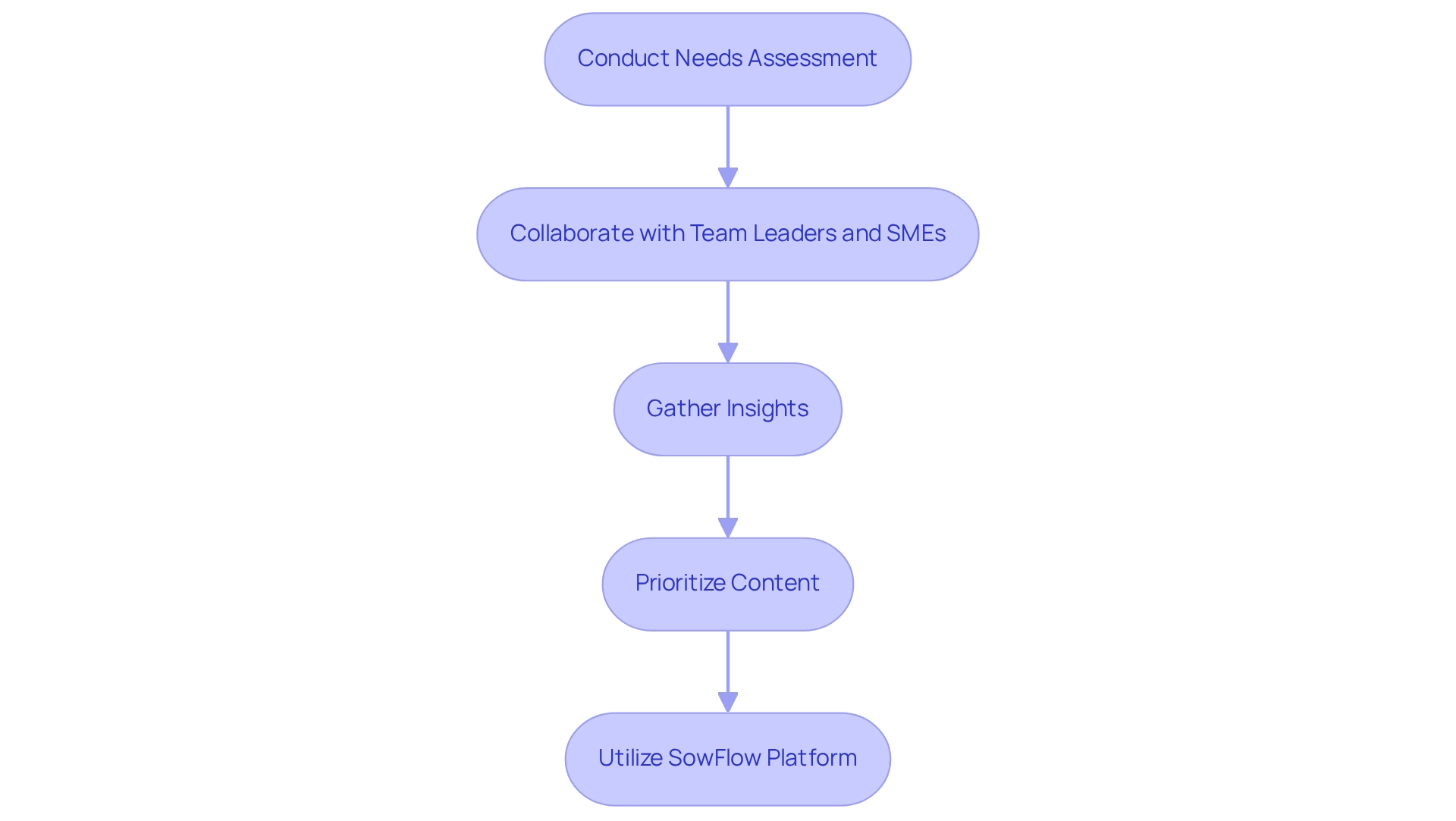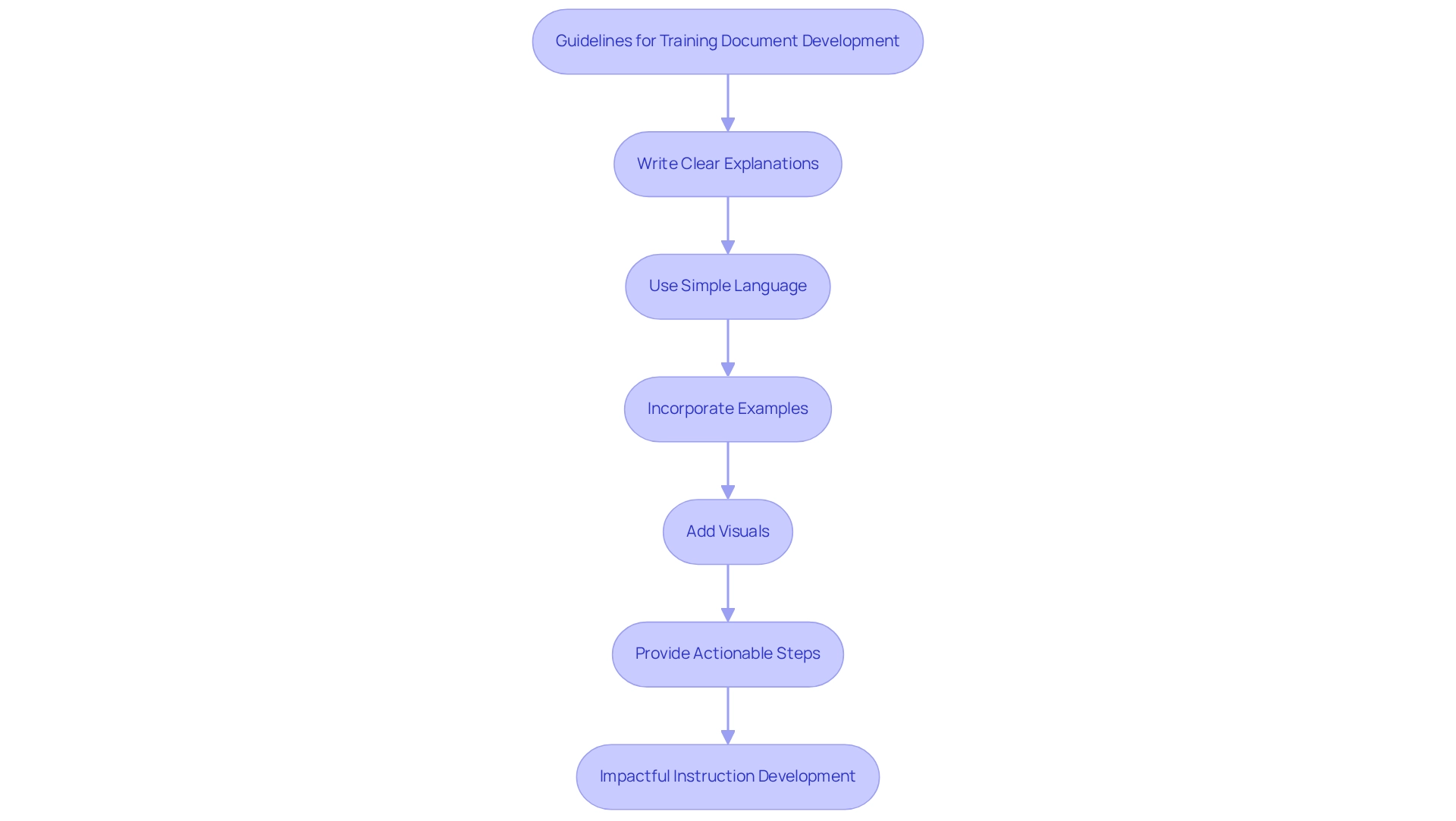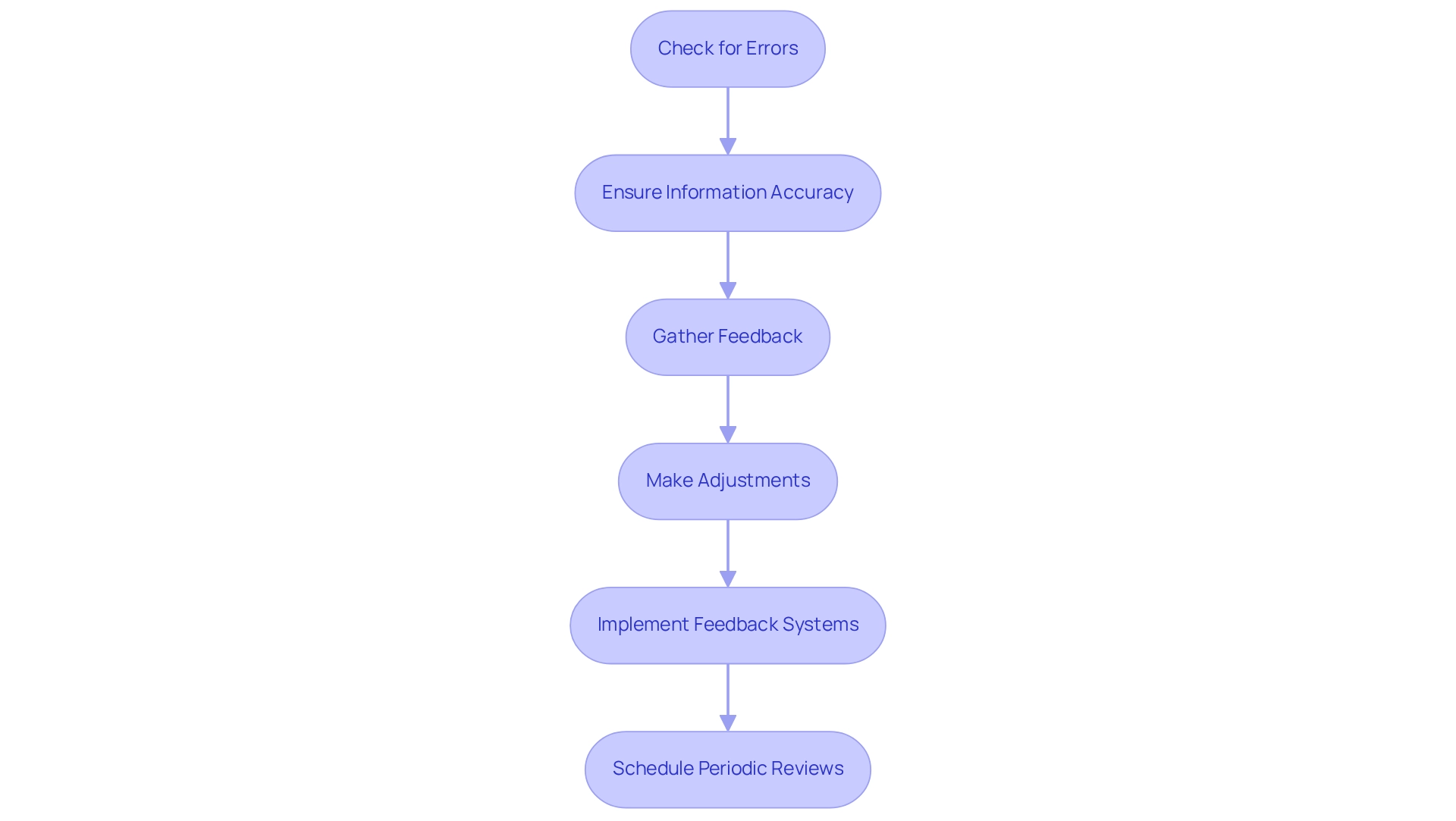
Streamlined Onboarding Processes
|
October 16, 2025
|
Create an Effective Training Document Template for Your Team
Overview
You might be wondering how to create an effective training document template for your team. It all starts with defining clear objectives and conducting needs assessments. Plus, collaborating with subject matter experts is key to ensuring that the content is relevant and useful.
Speaking of which, the importance of having structured and regularly updated instructional materials can't be overstated. These materials can really boost employee performance and engagement while also helping to cut down on onboarding costs.
So, let’s dive into how you can make this happen!
Key Highlights:
- Define clear objectives for training documents to enhance employee performance and engagement.
- Target specific groups, such as new recruits or current staff, for tailored educational initiatives.
- Effective training can lead to measurable results, including improved job engagement and reduced onboarding costs.
- Conduct a needs assessment to identify skill gaps and prioritize essential topics for training.
- Collaborate with subject matter experts to ensure content relevance and real-world application.
- Choose appropriate formats (PDF, online modules, etc.) and ensure a well-structured document for better knowledge transfer.
- Include clear objectives, main content sections, and actionable instructions in training materials.
- Review and revise training documents for accuracy, clarity, and professionalism, incorporating feedback from colleagues.
- Establish a regular update process for instructional materials to maintain relevance and effectiveness.
- Utilize tools like SowFlow to streamline the creation and management of training documents, enhancing overall efficiency.
Introduction
In today’s fast-paced workforce, you might be wondering just how crucial effective training documents really are. Well, organizations are catching on that well-structured training materials not only boost employee performance but also play a big role in job satisfaction and engagement. Did you know a whopping 92% of workers believe effective training positively impacts their work experience? The real challenge, then, is crafting documents that are clear, relevant, and actionable.
Now, let’s dive into the essential components of creating impactful training documents. We’ll explore everything from:
- Defining their purpose
- Pinpointing key content
- Choosing the right format
- Setting up a process for regular updates
By using innovative tools like SowFlow, organizations can streamline their documentation efforts, ensuring that their training resources stay effective and aligned with the ever-changing demands of the industry. So, are you ready to transform your training documents into something truly impactful?
Define the Purpose of Your Training Document
To clarify the purpose of your guide, let’s start by stating its primary objectives. You might be wondering:
- What specific skills or expertise should participants gain from this instruction?
- Who is the target group—are you focusing on new recruits, current staff, or specific divisions?
- What measurable results do you expect from this educational initiative?
By recording these points clearly, you’ll have a solid reference for creating your training document template. This clarity is crucial because organizations that invest in a training document template can significantly boost employee performance and engagement. Did you know that 92% of employees believe positively impacts their job engagement? This really highlights the importance of aligning educational objectives with broader organizational goals. Plus, statistics show that companies spend an average of $4,100 on onboarding new hires, which underscores the financial importance of effective development.
By ensuring that your instructional materials are purpose-driven and utilizing a training document template, you can streamline the onboarding process and cut down on time spent in repetitive meetings. This approach not only helps with knowledge retention but also creates a positive employee experience. In fact, 92% of survey participants agree that learning objectives should enhance such experiences.
Now, let’s talk about compliance. It’s essential to note that 34% of employees only skim through compliance information, which suggests a gap between content delivery and effectiveness. This really emphasizes the need for clarity in your training document template to ensure that vital information is effectively conveyed. Additionally, with about 30% of organizations outsourcing LMS functions to improve learning technologies, understanding the role of instructional materials is becoming increasingly important in today’s evolving education and documentation landscape.
Finally, aligning development initiatives with staff experience objectives, as highlighted in a case study on positive workforce experiences through education, can further amplify the impact of your instructional materials.
Identify Key Content and Skills to Include
Creating an effective training document template? You might start by compiling a list of essential topics and skills that need to be addressed. First up, conduct a thorough needs assessment to pinpoint those pesky gaps in knowledge or skills within your team. This step is crucial, especially since research shows that fewer than 40% of executives are satisfied with their organization's investment in employee development. That really highlights the urgency for focused educational initiatives, doesn’t it? Plus, with job listings related to generative AI skyrocketing by more than 250% since 2021, it’s clear that the landscape of skills and education requirements is changing fast.
Now, let’s talk about collaboration. Work with team leaders and subject matter experts (SMEs) to gather insights on the critical areas that need attention. Involving SMEs not only boosts the content but also ensures that the instruction aligns with real-world applications. For instance, organizations that have rolled out have successfully closed skills gaps and prepared their teams for future advancements.
Once you've gathered all that input, it’s time to prioritize the content based on its importance to your educational goals and the specific needs of your audience. This targeted strategy will lead to a more efficient resource, allowing your team to thrive in a rapidly evolving business landscape.
And here’s where this platform can really shine! It simplifies the development of Standard Operating Procedures (SOPs) and training document templates for creating instructional materials. As Anastasia Masadi, a Product Owner, puts it, 'This tool has been a game changer in the way we document work and deliver to our clients.' I mean, who wants to capture each screenshot individually? With this service, you don’t even need to exit the browser while creating SOPs and educational materials. It’s like getting a slice of your life back! By utilizing SowFlow's features, you can effectively tackle those content creation deficiencies, ensuring a more skilled and flexible workforce ready to meet industry demands.

Choose the Format and Structure of the Document
Choosing the right format and organization for your instructional material, like , is super important for effective knowledge transfer. You might be wondering what your options are.
-
Format: First off, think about whether you want the document to be a PDF, an online module, or a printed manual. Each format has its perks; for instance, online modules are easy to update and access, while printed manuals might be your go-to for hands-on sessions. Plus, using a centralized knowledge base can really enhance the learning experience by making sure everyone has access to the latest info. With SowFlow, you can easily create and update user guides, keeping your documentation relevant in our fast-paced business world.
-
Structure: Now, let’s talk about organizing your content in a way that makes it easy to read and understand. A well-structured document usually includes:
- Introduction: This is where you set the stage for what the training will cover.
- Objectives: Clearly outline what you aim to achieve in the training session.
- Main Content Sections: Break the material into bite-sized pieces, using headings and subheadings for clarity.
- Summary or Conclusion: Wrap up with the key points to reinforce learning.
- Appendices or Additional Resources: Offer extra info that can help with understanding or further exploration.
Using bullet points and visuals can really amp up engagement and retention. Research shows that well-structured documents can boost learning outcomes, making it easier for employees to absorb and apply new information. Ultimately, pick a training document template that fits your audience's needs and the specific content of the session. This thoughtful approach not only encourages a mindset of continuous improvement but also ensures your educational resources are effective and accessible, especially when using instant documentation solutions.
Develop the Content for Your Training Document
Creating effective content for your training document using the platform? Let’s dive into some guidelines that can help you out:
You might be wondering how to start. Well, writing clear and concise explanations for each topic is key. Make sure every point is easily understood! The platform’s user-friendly interface allows you to create these explanations effortlessly, ensuring a smooth creation process.
Now, let’s talk about language. Using simple terms and avoiding jargon can really enhance understanding among all users. And guess what? With this platform, you can instantly update your documentation to keep it relevant and accessible for everyone.
Have you thought about incorporating examples, case studies, or scenarios? They can illustrate key concepts and make the material relatable and practical. This tool empowers you to summon the wisdom of your documentation with a single command, enhancing the relatability of your content.
Also, don’t forget about visuals! Charts, diagrams, or images can be super helpful. Research shows that our brains can interpret visual data in , which means considerable time savings in preparation while boosting overall productivity and operational efficiency. The platform makes it easy to add visuals to your instructional documents.
Finally, ensure that the content is actionable by providing step-by-step instructions where applicable. This way, users can apply what they learn immediately. SowFlow's platform simplifies this process, helping you create actionable guides that improve team efficiency.
By following these steps and utilizing SowFlow's features, you can create a training document template that not only communicates information effectively but also captivates users. Remember, inadequate instruction can lead to an estimated loss of $13.5 million each year for every 1,000 employees. That’s a big deal, highlighting the significance of developing impactful instructional materials!

Review and Revise Your Training Document Template
Once you've developed the content for your training document template, it's time for a thorough review to ensure it's truly effective. You might be wondering where to start—well, begin by checking for grammatical mistakes, typos, and any formatting inconsistencies. These little errors can really undermine the professionalism of your text. Next up, make sure all the information is accurate and up-to-date. Outdated content? That's a recipe for confusion and inefficiencies.
Gathering feedback is a crucial step in this process. Engaging your colleagues or even subject matter experts can provide you with a variety of perspectives that really enhance the quality of your training document template. Did you know that research shows 42% of employees struggle to find and share information due to disorganized data? This highlights just how important clear and accessible educational materials are. As Anastasia Masadi, a Product Owner, puts it, 'This tool has been a game changer in the way we document work and deliver to our clients.' I mean, who doesn’t want to save time? With this service, I no longer have to capture each screenshot individually, and I can whip up SOPs and instructional materials without even leaving my browser. This is how SowFlow helps teams create SOPs and educational materials quickly, revolutionizing documentation workflows with features that simplify the development and management of instructional materials.
After you’ve gathered that valuable feedback, it’s time to tweak the text. Make the necessary adjustments to boost clarity and effectiveness, ensuring your educational materials are not just informative but also user-friendly. Implementing organized feedback systems—think surveys, collaborative review sessions, or peer evaluations—can really up the quality of your training document template.
And let’s not forget, consistently assessing and updating your instructional materials is key to keeping everything precise and relevant. Best practices? Set a schedule for periodic reviews and build in feedback loops that allow for continuous improvement. The future of document management is all about harnessing predictive analytics and integrating AI and machine learning. These tools can streamline your review process and enhance the quality of your documents. By prioritizing these steps, you can create strong educational materials using a training document template that supports operational excellence and makes onboarding smoother. So, why not arrange a demonstration to see how this platform can boost ?

Establish a Process for Regular Updates
To keep your instructional materials running smoothly, you might be wondering how to create a structured strategy for periodic revisions. Here’s a plan you can follow:
- Scheduled Reviews: Think about setting a timeline for evaluations—quarterly or bi-annually could work well—to ensure your content stays relevant and accurate. Studies show that organizations that frequently update their educational materials experience a significant boost in participant satisfaction and learning outcomes.
- Designated Responsibilities: It’s a good idea to assign specific team members to keep an eye on content relevance. This way, you ensure accountability and focus.
- Feedback Mechanism: How about implementing a system that lets users report outdated info or suggest improvements? This fosters a culture of continuous enhancement.
- Version Control: Don’t forget to maintain ! Tracking changes and updates is essential for understanding how your material has evolved and ensuring compliance with current practices.
Now, let’s dive into how SowFlow can help you streamline this process. With unlimited access to all software features and dedicated customer success agents, your team will be well-equipped to arrange files efficiently and set up a genuine documentation system. By organizing your procedures, you not only keep your instructional materials up-to-date but also boost their overall efficiency, leading to better staff performance and satisfaction.
Moreover, assessing the effectiveness of employee development programs is crucial for organizations. Metrics like participant satisfaction and learning outcomes can really help gauge program impact and align initiatives with your overall objectives. By prioritizing these practices, you can ensure that your training document template becomes a valuable asset in your operational toolkit. Plus, SowFlow offers competitive pricing options that provide comprehensive support, making it an ideal choice for organizations looking to enhance .
Conclusion
You know, effective training documents are super important for building a productive and engaged workforce. When organizations clearly define the purpose of their training materials, they can really hit the mark in meeting their employees' specific needs and aligning with broader business goals. It’s all about identifying key content and skills through thorough needs assessments and teaming up with subject matter experts. This is crucial for tackling those knowledge gaps and getting teams ready for the ever-changing demands of the industry.
Now, let’s talk about choosing the right format and structure for those training documents. Doing so enhances readability and comprehension, making it easier for employees to soak up critical information. Developing content that’s clear, actionable, and visually engaging really supports effective learning experiences. Plus, regularly reviewing and revising training materials keeps them fresh and relevant. A structured process for updates is key to fostering continuous improvement.
Ultimately, organizations that make effective training documentation a priority not only boost employee performance and satisfaction but also cultivate a more agile and adaptable workforce. By embracing innovative tools like SowFlow, companies can streamline their documentation processes, ensuring that training resources stay impactful and in tune with the fast-paced changes in the work environment. So, embracing these practices is a vital step toward transforming training documents into valuable assets that contribute to long-term success. What do you think? Ready to dive deeper into the world of effective training documentation?
Frequently Asked Questions
What are the primary objectives of creating a training document template?
The primary objectives include identifying specific skills or expertise participants should gain, determining the target group (new recruits, current staff, or specific divisions), and establishing measurable results expected from the educational initiative.
Who is the target audience for the training document?
The target audience can include new recruits, current staff, or specific divisions within the organization, depending on the focus of the training initiative.
What measurable results should be expected from the educational initiative?
Measurable results may include enhanced employee performance, increased engagement, and improved knowledge retention among participants.
How does investing in a training document template benefit organizations?
Investing in a training document template can significantly boost employee performance and engagement, streamline the onboarding process, and reduce time spent in repetitive meetings.
What statistics highlight the importance of effective workplace education?
Research shows that 92% of employees believe effective workplace education positively impacts their job engagement, and companies spend an average of $4,100 on onboarding new hires.
What is the significance of clarity in compliance training materials?
Clarity in compliance training materials is essential because 34% of employees only skim through compliance information, indicating a gap between content delivery and effectiveness.
How can organizations improve their learning technologies?
About 30% of organizations are outsourcing Learning Management System (LMS) functions to improve learning technologies, emphasizing the need for effective instructional materials.
What steps should be taken to create an effective training document template?
Steps include conducting a needs assessment to identify knowledge gaps, collaborating with team leaders and subject matter experts, prioritizing content based on educational goals, and utilizing tools that simplify the development of instructional materials.
Why is collaboration important in developing training content?
Collaboration with team leaders and subject matter experts ensures that the instruction aligns with real-world applications and addresses critical areas that need attention.
How does the evolving landscape of skills and education requirements impact training?
The landscape is changing rapidly, with job listings related to generative AI increasing by over 250% since 2021, underscoring the urgency for focused educational initiatives to keep up with industry demands.
👍
What others are liking
5 Steps to outline your ideal documentation structure
5 MINS READ
Where to start the your journey of mapping out your ideal documentation structure, aligning it with the very heartbeat of your organization?
Defining a winning level of detail in your process
3 MINS READ
What is too much detail, and what is too little? This article described in that winning level detail about what detail is enough.





